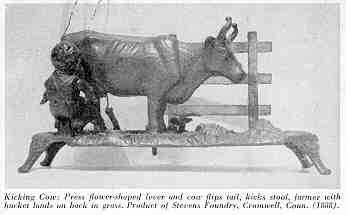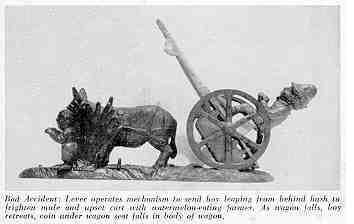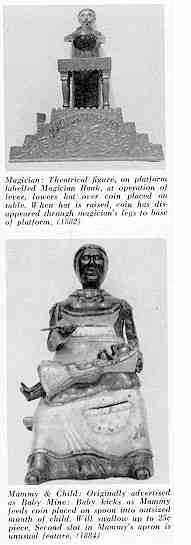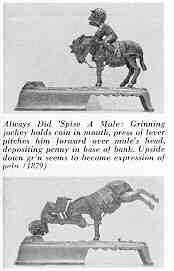Though an extensive collection may seem out of the question, every collector of Americana may own at least one of these
Mechanical
Banks
By William H. Montgomery (Photos by Doris E. Montgomery)
THE SPINNING WHEEL for February 1957
 ANTIQUE mechanical
banks have long been collectors' items. Today they are being so assiduously sought by
bankers and financial institutions as well as established collectors that the casual
collector may find them so scarce as to seem almost unobtainable. Prices, too, have
spiraled to such fantastic heights as to discourage the newcomer from the thought of
acquiring a sizeable collection. However, at least one antique bank, either a good
mechanical or a good still, is within range of every collector's purse and province - and
belongs in every over-all collection of Americana.
ANTIQUE mechanical
banks have long been collectors' items. Today they are being so assiduously sought by
bankers and financial institutions as well as established collectors that the casual
collector may find them so scarce as to seem almost unobtainable. Prices, too, have
spiraled to such fantastic heights as to discourage the newcomer from the thought of
acquiring a sizeable collection. However, at least one antique bank, either a good
mechanical or a good still, is within range of every collector's purse and province - and
belongs in every over-all collection of Americana.
These banks, which reached their height of popularity in the 1870s and 1880s, though some
were made earlier, and others as late as 1915, were primarily toys rather than objects for
the encouragement of thrift. Nearly all of them can be operated by pressing the lever or
knob without the necessity of depositing a coin. Because most of the banks were of iron,
shatterable if dropped, it is no wonder that a majority of those manufactured have been
broken. The chipped and worn paint on many remaining attest to hard use through the years.
 A large part of the charm of these old
banks stems from the fact that they are pure Americana. Even the substance of which they
were manufactured, iron, was not plentiful enough in other countries to be used in
children's toys. However, iron foundries in the United States found toys profitable, and
employed really good artists to design the banks and plan the concealed mechanisms which
made the parts move. The designers used many familiar figures in their choice of subject.
Banks appeared featuring such typical American sports as baseball, football and bowling,
or such popular types of entertainment as magicians, Punch & Judy Shows, performing
animals, and acrobats. They ranged from a Preacher in the Pulpit bank to popular comic
strip characters, like Uncle Remus, the Katzenjammer Kids and the "Shoot the
Chutes" bank with Buster Brown and Tigue.
A large part of the charm of these old
banks stems from the fact that they are pure Americana. Even the substance of which they
were manufactured, iron, was not plentiful enough in other countries to be used in
children's toys. However, iron foundries in the United States found toys profitable, and
employed really good artists to design the banks and plan the concealed mechanisms which
made the parts move. The designers used many familiar figures in their choice of subject.
Banks appeared featuring such typical American sports as baseball, football and bowling,
or such popular types of entertainment as magicians, Punch & Judy Shows, performing
animals, and acrobats. They ranged from a Preacher in the Pulpit bank to popular comic
strip characters, like Uncle Remus, the Katzenjammer Kids and the "Shoot the
Chutes" bank with Buster Brown and Tigue.
Many of them portray a raucous humor, with people getting into accidents, often with
animals as the cause of the trouble. Butting goats, kicking cows, bucking mules and
buffalo provided slapstick comedy. The animals are generally well-proportioned and
pleasing to the eye, and the people, lovable and good-humored, never seemed to mind much when
they are knocked over to stand on their heads or lie flat on their backs. Often the
exaggerated facial expressions are very funny. The old bank designers, in their zeal to
make the children laugh, created masterpieces of humor which have fascinated generations
of adults as well.
The prices of old mechanical banks vary a great deal depending on their rarity. While the
"Kicking Cow" and "Always Did 'Spise a Mule" are perhaps equally
attractive and similar in action, the "Kicking Cow" is much more rare. John D.
Meyer's book, copyright in 1952, prices this " 'Spise a Mule" bank at $22, and
the Kicking Cow bank at $200.
The Dentist bank, pictured, was originally sold by the manufacturer for $8 a dozen. The
selling price listed by Ina Hayward Bellows in her Old Mechanical Banks, published in
1940, was between $20 and $30 each. In 1952, John D. Meyer in his Handbook of Old
Mechanical Penny Banks, set the current price at $165. In April 1955, a catalogue
published by David Hollander, New York, offering for
sale a number of mechanical and still banks from the Chrysler Collection, listed the same
bank, in fine condition, with original paint at $350. It is a safe guess that today's
spiraling prices will seem low to a future generation.
In the parlance of the trade, "O.P." means "Original Paint" and
"O.F.," "Original Finish." A bank is said to be in "mint"
condition if it still has all or virtually all of its original paint. Of course, a bank
which is "mint" is worth more than the same bank in a badly faded condition, or
with much of the paint gone or badly chipped. However, most collectors want nothing
whatever to do with a bank that has been repainted. Hence an old bank, even with little or
none of its original paint left is more valuable than if repainted. Many repaint jobs are
crude in both conception and execution, but even the most expert restorer, bent on
deception, would find it as hard to repaint a bank in the original colors to fool a
connoisseur of banks as to counterfeit money to deceive a Treasury man.
Non-experts who contemplate buying a mechanical bank would do well to seek the advice of
experienced bank collectors in order to avoid the pitfalls of buying a repainted job,
worth, perhaps, only a fraction of the price asked, or of paying a too high a price for
one of the less rare banks.
It is to be remembered that some of the most attractive mechanical banks are the cheapest
because they were immensely popular and sold in the largest numbers. Rarer banks may be
those which were more fragile, or ones with less popular appeal which were manufactured in
small quantities. Some of the rarest of all are ones which a manufacturer put on the
market only to find he could not sell them advantageously and withdrew the model after a
comparatively small number had been made.



